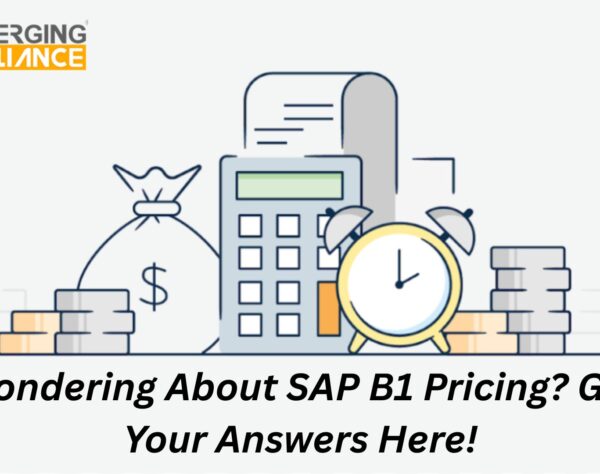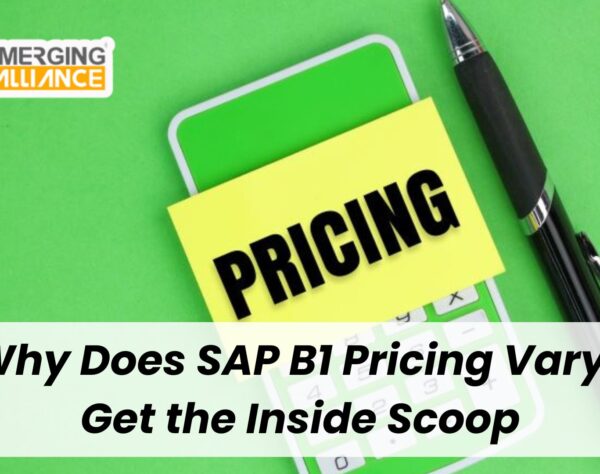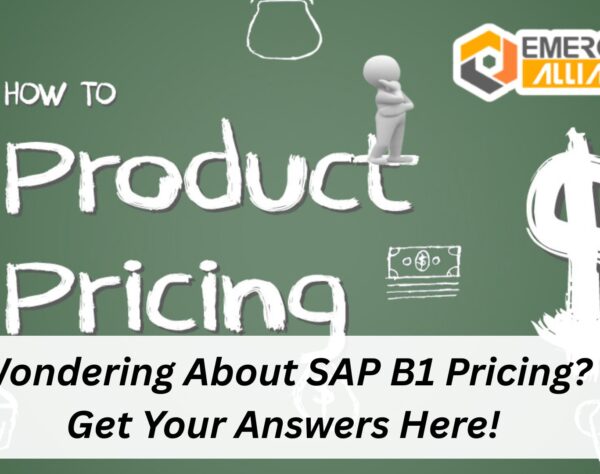
SAP B1 Pricing for Healthcare Industry: A Complete Cost Guide

Why SAP Business One is Making Headlines in Healthcare Industry
The future of healthcare is data-driven, automated, and deeply integrated. In this digital age, where patients expect faster services and administrators demand error-free operations, SAP B1—also known as SAP Business One—is becoming the go-to ERP solution. But one question echoes across boardrooms and clinics alike: How does SAP B1 pricing work for the healthcare industry?
While this guide will not mention specific numbers, it unpacks every aspect of SAP Business One pricing tailored for healthcare, helping decision-makers confidently map out their ERP investment.
The Need for SAP B1 in Healthcare: A Pulse Check
From managing patient records to coordinating procurement for medical supplies, the complexity of healthcare operations demands more than spreadsheets or legacy systems. Here’s why SAP B1 is fast becoming the white coat of ERP for this sector:
- Real-time visibility into patient flow, medical inventory, and financials
- Compliance management aligned with healthcare regulations like HIPAA
- Integrated modules to replace siloed systems
- Enhanced decision-making through actionable data and analytics
In short, SAP Business One isn’t just another software—it’s a unified digital heartbeat for your healthcare operations. And understanding the structure behind SAP B1 pricing helps organizations scale with clarity and control.
What Drives SAP B1 Pricing in the Healthcare Sector?
When choosing an ERP, especially in healthcare, the conversation around pricing is about value, not just cost. Here are the key components influencing SAP B1 pricing:
1. Number of Users
Whether you run a multi-specialty hospital or a diagnostic lab, the number of users accessing SAP Business One directly affects your license model. More users = higher license tiers.
2. Module Selection
Healthcare institutions might not need every module. However, key ones like inventory, finance, patient record integration, and procurement are often essential—each adding to the overall SAP B1 pricing.
3. Customization Needs
Out-of-the-box is great. But healthcare isn’t a one-size-fits-all industry. Whether it’s lab integration, appointment scheduling, or mobile health monitoring—tailored features influence pricing.
4. Hosting Type: Cloud or On-Premise
Cloud deployments typically bundle hosting and updates, while on-premise gives more control. Each hosting method has different pricing implications in the SAP Business One ecosystem.
5. Maintenance & Support
Round-the-clock support is a must in healthcare. The level of service you choose—basic to premium—impacts SAP B1 pricing over time.
SAP Business One Features That Justify the Price Tag in Healthcare
The beauty of SAP Business One lies in its modular design. For healthcare specifically, these features create long-term value:
- Inventory Management for Medical Supplies: Know exactly what you have and what you need, avoiding stockouts and wastage.
- Patient Billing Integration: Seamless tracking of services rendered and billing accuracy.
- Multi-location Management: Ideal for hospital chains or diagnostic networks.
- Data Security: HIPAA-compliant features ensure privacy and protection of patient data.
- Compliance Reporting: Simplifies audits, accreditation processes, and internal checks.
These aren’t just features; they’re tools to reduce errors, save time, and improve patient outcomes—all within a customizable SAP B1 pricing framework.
How Healthcare Organizations Can Optimize SAP B1 Pricing
To get the best return on your SAP Business One investment, healthcare providers should:
- Conduct a workflow audit to determine which modules are truly necessary.
- Choose a scalable user model—start small and expand as needed.
- Engage with an experienced SAP B1 healthcare partner to reduce unnecessary costs.
- Explore hybrid deployment options to balance flexibility and control.
- Plan for training and change management, as successful adoption drives full ROI.
When planned strategically, SAP B1 pricing becomes an investment in operational excellence—not an expense.
Hidden Value Within SAP B1 Pricing Models
Here’s a perspective-shifter: SAP B1 pricing isn’t just a cost—it’s a gateway to value realization. What may seem like a higher upfront cost is often justified by:
- Time saved across departments
- Fewer compliance violations
- Increased patient satisfaction
- Greater visibility into KPIs and performance metrics
And with the flexible licensing models SAP offers, you only pay for what your healthcare business truly needs.
Common Pricing Mistakes Healthcare Teams Make (And How to Avoid Them)
Even the most tech-savvy healthcare organizations can stumble when navigating SAP Business One pricing. Common pitfalls include:
- Overbuying modules not aligned with actual workflows
- Ignoring the importance of post-implementation support
- Underestimating the role of data migration and training costs
- Choosing generic ERP consultants instead of healthcare-focused SAP B1 partners
Avoiding these errors ensures your SAP B1 pricing is efficient, sustainable, and aligned with long-term goals.
SAP B1 is the Healthcare Ally You’ve Been Waiting For
Implementing SAP Business One in the healthcare sector is a strategic leap forward. With adaptable modules, strong compliance features, and user-friendly dashboards, SAP B1 empowers hospitals, clinics, and diagnostic labs to function with precision and purpose.
Understanding SAP B1 pricing is your first step in making an informed decision. When chosen wisely and implemented with the right guidance, SAP Business One becomes the digital backbone of your healthcare operation.
✅ FAQs
1. How does SAP B1 support remote healthcare services without increasing pricing drastically?
SAP Business One enables cloud-based remote access, which reduces infrastructure costs while ensuring performance, keeping pricing controlled.
2. Can SAP Business One integrate with hospital EMR or EHR systems?
Yes, SAP B1 can be integrated with EMR/EHR platforms via APIs or middleware, though customization may influence pricing.
3. Does SAP B1 offer separate pricing models for NGOs or non-profit healthcare clinics?
While SAP itself doesn’t publicly offer NGO pricing, implementation partners may provide flexible pricing for such use cases.
4. What’s the impact of regulatory compliance on SAP B1 pricing for healthcare?
Regulatory features often require added configurations or modules, which can influence SAP B1 pricing based on the region and laws.
5. Can a small clinic afford SAP Business One pricing realistically?
Yes, with proper module selection and a phased approach, small clinics can afford SAP B1 within a manageable pricing range.
6. Is pricing different for public vs. private healthcare institutions using SAP B1?
While the core pricing model remains the same, licensing strategies may differ based on scale, funding, and customization needs.
7. What training costs should healthcare providers consider with SAP Business One?
Training varies based on user roles and depth of use, which should be factored into overall SAP B1 pricing estimates.
8. Can SAP B1 pricing be optimized by phasing implementation across departments?
Yes, phased implementation helps control initial investment and allows teams to adapt gradually, optimizing overall pricing impact.
9. Are there any SAP B1 modules designed specifically for pharmacy inventory in healthcare?
While not exclusive to pharmacies, SAP B1’s inventory module can be customized for pharmacy workflows within healthcare settings.
10. Does SAP Business One offer analytics tools for cost control in healthcare?
Yes, SAP B1 includes built-in dashboards and reporting tools that help healthcare teams track spending and optimize pricing efficiency.







